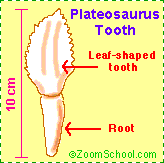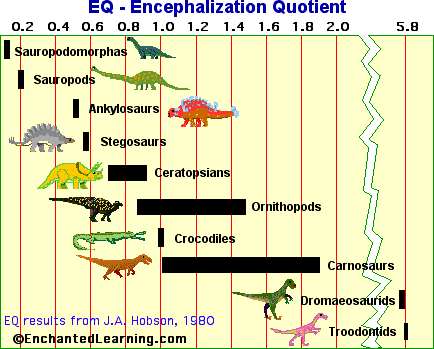Advertisement.
EnchantedLearning.com is a user-supported site.
As a bonus, site members have access to a banner-ad-free version of the site, with print-friendly pages.
Click here to learn more.
(Already a member? Click here.)
PLATEOSAURUS
"Flat Lizard"

ANATOMY
Plateosaurus was a large, early herbivore that was about 27.5 feet (8 m) long and weighed about 1,500 pounds (700 kg). It had a long neck, very long tail, a small head with a long snout, and large, five-fingered hands with a large thumb claw (and smaller claws on the other fingers). Plateosaurus may have been able to use its hand for grasping in addition to walking. Its back legs were larger than its front legs. It was a very common dinosaur in Europe during the late Triassic period.
WHEN PLATEOSAURUS LIVED
Plateosaurus lived about 222-219 million years ago, during the late Triassic period. Among its contemporaries in Triassic Europe were Saltopus and Proganochelys
and Proganochelys  , the earliest-known turtle.
, the earliest-known turtle.
ENVIRONMENT
Plateosaurus lived in a dry, almost desert-like environment in what is now Europe.
CLASSIFICATION
Plateosaurus was a Saurischian dinosaur, the order of lizard-hipped dinosaurs. It was a prosauropod or sauropodomorpha (long-necked, semi-quadrupedal herbivores) and a plateosaurid (heavy, thick-limbed herbivores that include Massospondylus, Mussaurus, and Plateosaurus).
BEHAVIOR
Plateosaurus may have congregated in herds, and may have migrated seasonally across the arid (dry) European landscape during the late Triassic period.
DIET AND TEETH
 Plateosaurus was one of the first tall, long-necked herbivores (plant eaters). It was probably able to rear up on its back legs in order to graze on tall vegetation, like conifers and cycads. Its sharp teeth let it tear these tough leaves from the plants. It may have swallowed pebbles and small stones to help in the digestion of the tough leaves and other plant material that it ate. These gizzard stones (gastroliths) would help grind up the food in the stomach.
Plateosaurus was one of the first tall, long-necked herbivores (plant eaters). It was probably able to rear up on its back legs in order to graze on tall vegetation, like conifers and cycads. Its sharp teeth let it tear these tough leaves from the plants. It may have swallowed pebbles and small stones to help in the digestion of the tough leaves and other plant material that it ate. These gizzard stones (gastroliths) would help grind up the food in the stomach.
INTELLIGENCE
Plateosaurus was a sauropodomorpha, whose intelligence (as measured by its relative brain to body weight, or EQ) was the lowest among the dinosaurs.

DEFENSE
Plateosaurus had short claws on its front and rear limbs, and weak, leaf-shaped teeth. These paltry defenses were probably not very effective against large predators, which had bigger claws, sharper teeth, and were stronger overall. Its best defense was to run away.
LOCOMOTION
Plateosaurus walked on four muscular legs, but may have been able to rear up on its back legs to eat tall vegetation.
DISCOVERY OF FOSSILS
Plateosaurus is one of the most common dinosaur fossils found in Europe; it has been found in over 50 European locations. It was first described (and named) by the German paleontologist Hermann von Meyer in 1837.
PLATEOSAURUS ACTIVITIES
 Information Sheets About Dinosaurs Information Sheets About Dinosaurs
(and Other Prehistoric Creatures) |
Just click on an animal's name to go to that information sheet. If the dinosaur you're interested in isn't here, check the Dinosaur Dictionary or the list of Dinosaur Genera. Names with an asterisk (*) were not dinosaurs.
How to write a great dinosaur report.
For dinosaur printouts, click here.For brief dinosaur fact sheets, click here.
Enchanted Learning®
Over 35,000 Web Pages
Sample Pages for Prospective Subscribers, or click below
Click to read our Privacy Policy
Enchanted Learning Search
|
Search the Enchanted Learning website for:
|
Advertisement.
Advertisement.
Copyright ©1996-2018
EnchantedLearning.com ------ How to cite a web page


